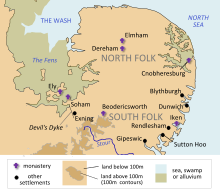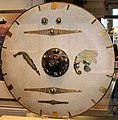Sutton Hoo
Sutton Hoo is an archaeological dig near the town of Woodbridge , Suffolk , in the East Anglia region of eastern England .
In 1939, local archaeologist Basil Brown found a 7th century Anglo-Saxon boat grave in Sutton Hoo on the high bank of the River Deben in Suffolk , which apparently had been spared grave robbers . The rich additions to the burial equipment of an Anglo-Saxon prince or leader show local, Irish, Scandinavian, Merovingian and Eastern Mediterranean influences. For example, analyzes of bitumen found on the ship show that it comes from the Middle East. For the silver finds from the ship's grave, see Silver finds from the ship 's grave at Sutton Hoo .
The ruler buried there was sent on the last voyage in a 27 m long and 4.5 m wide longship . In historical research it is mostly assumed that this ruler was Rædwald of East Anglia († between 617 and 625), although this is not certain. The Merovingian coinage at the right time and his position of power at this time speak for Raedwald, to which the rich grave goods fit. In the entry of the year 827 (829) of the A-manuscript of the Anglo-Saxon Chronicle , which in turn is based on information in Beda's Historia ecclesiastica gentis Anglorum, he is referred to as Bretwalda .
The hull was made of overlapping planks that were held together with iron nails. There was space for about 20 rowers on both sides. There is no evidence of sails.
Martin Carver's excavations uncovered other rich graves in the vicinity of the hill. After the Christianization of the Angel Saxons, the area served as a place of execution , the bodies of some victims have been preserved as sand molds.
Sutton Hoo is now owned by the National Trust . The area with the burial mounds, some of which have been refilled, can be visited via two circular routes. In the entrance area there is a recently opened museum, in which, among other things, an elaborate model of the royal tomb can be seen. There are also replicas of the finds from 1939, including a gold helmet. The original is in the British Museum in London . The finds from Martin Carver's excavations will be exhibited on site.
- Parts of the Sutton Hoo find in the British Museum or in the Sutton Hoo Exhibition Hall
Spangenhelm of a warrior prince from the grave near Sutton Hoo, which probably belonged to King Rædwald ( helmet of Sutton Hoo ).
literature
- Martin Carver: Sutton Hoo. A Seventh-Century Princely Burial Ground and its Context (= Reports ot the Research Committee of the Society of Antiquaries of London 69). British Museum Press, London 2005, ISBN 0-7141-2322-6 .
- Calvin B. Kendall, Peter S. Wells (Eds.): Voyage to the Other World. The Legacy of Sutton Hoo. University of Minnesota Press, Minneapolis 1992.
- Michael Parker Pearson, Robert Van De Noort, Alex Woolf: Three men and a boat. Sutton Hoo and the East Saxon kingdom. In: Anglo-Saxon England 22, 1993, pp. 27-50.
Web links
- Sutton Hoo on the website of the National Trust (Engl.)
- The Sutton Hoo ship burial. Detailed 3D-model of the reconstructed helmet at Rotharis.de
Remarks
- ↑ Sutton Hoo bitumen left Syria with Anglo-Saxon England. BBC , December 1, 2016, accessed December 13, 2016 .
- ↑ See for example Nicholas J. Higham, Martin J. Ryan: The Anglo-Saxon World. New Haven 2013, p. 133.
- ^ Barry Cunliffe: Facing the ocean: the Atlantic and its peoples, 8000 BC-AD 1500. New Haven 2008, p. 436.
Coordinates: 52 ° 5 ′ 20 ″ N , 1 ° 20 ′ 11 ″ E







